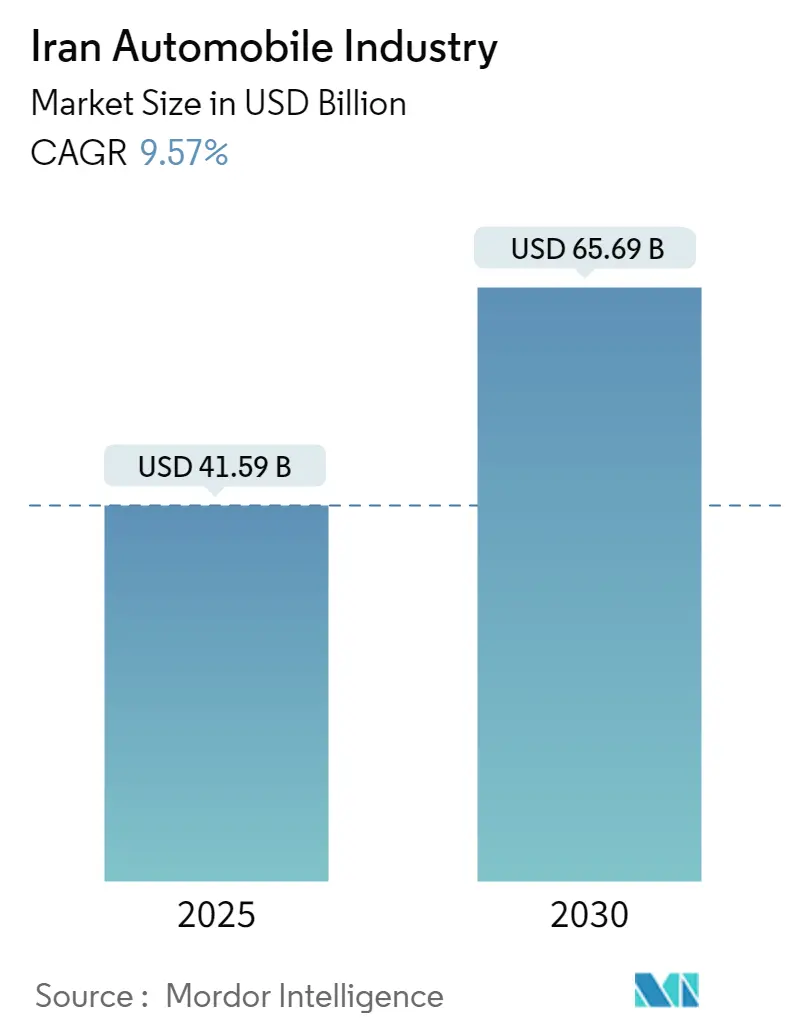
| Study Period | 2019 - 2030 |
| Base Year For Estimation | 2024 |
| Forecast Data Period | 2025 - 2030 |
| Market Size (2025) | USD 41.59 Billion |
| Market Size (2030) | USD 65.69 Billion |
| CAGR (2025 - 2030) | 9.57 % |
| Market Concentration | Medium |
Major Players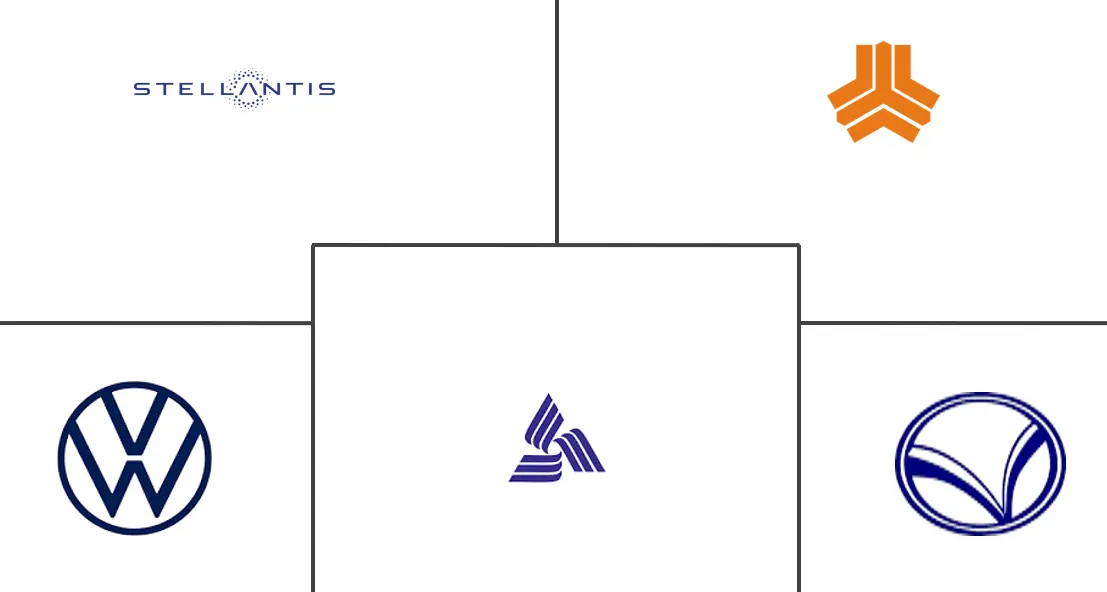
*Disclaimer: Major Players sorted in no particular order |
Iran Automobile Market Analysis
The Iran Automobile Industry is expected to grow from USD 41.59 billion in 2025 to USD 65.69 billion by 2030, at a CAGR of 9.57% during the forecast period (2025-2030).
Iran’s automobile industry is of economic and political importance to the government and functions as a solid infrastructure for increased production.
The industry accounts for 10% of Iran's GDP and 4% of its workforce, second only to the oil and gas industry. There are around 13 public and private auto manufacturers in Iran, with IKCO and SAIPA accounting for about 94% of the domestic production.
The Iranian automobile industry was struggling before the COVID-19 pandemic. Iran was one of the most severely affected countries in the world during the first wave of the pandemic globally. The virus led to lockdowns and shutdowns of vehicle and vehicle component manufacturing facilities, dealerships, and showrooms, resulting in less demand and decreased production.
The major car manufacturers in the country are increasing their production with locally manufactured parts and components. For instance,
- In March 2023, IKCO, the largest car manufacturer in Iran, announced its first electric car for commercial purposes, which was launched in Iran. The IKCO technology arm Jetco designed and developed this model with a battery pack of 45 kWh, which can travel 300 km on a full charge.
Over the long term, local OEMs and major manufacturers in the country are expected to sign agreements and form associations with the university and research institutes to upgrade the manufacturing technology related to auto parts and components, which is expected to boost the market during the forecast period. For instance,
- In October 2022, six MoUs were signed between Iran Khodro Industrial Group and Saipa Automobile Group, covering the supply and purchase of raw materials and parts. These agreements also aim to establish joint engineering and R&D centers for manufacturing automobiles in the country.
With an annual production of more than 1.6 million vehicles, Iran is the world's 20th-largest automaker and one of the largest in Asia. Currently, Iranian manufacturers produce six vehicles: passenger cars, 4WD trucks, buses, minibusses, and pick-up trucks. Passenger cars account for approximately 75% of local output, with pick-up trucks accounting for about 15%.
Iran Automobile Market Trends
Growing Passenger Car Sales to Have a Positive Impact on the Market
In recent years, the Iranian automobile market has experienced a significant boost due to the burgeoning sales of passenger cars. This surge in demand for passenger vehicles has contributed to the automobile industry's expansion and positively impacted the country's overall economic landscape. This trend reflects a changing consumer preference and an optimistic outlook for the Iranian automobile industry. For instance,
- According to the International Organization of Motor Vehicle Manufacturers (OICA), Iran's car output reached 1.188 million units in 2023 and took 16th place in the world car production.
Several factors contribute to the growing popularity of passenger cars in Iran. A key driver is the rising disposable income among the middle-income population, enabling more individuals and families to afford personal vehicles. Additionally, the increasing urbanization and changing lifestyles have heightened the need for convenient and efficient transportation, fueling the demand for passenger cars.
Government initiatives and policies have played a crucial role in fostering the growth of the automobile industry. In Iran, efforts to stimulate economic development have led to the implementation of supportive measures, such as reduced import tariffs, subsidies, and financing schemes, making it more feasible for consumers to purchase passenger cars. These policies create a favorable environment for manufacturers and buyers, driving market expansion.
The Cabinet of Ministers has requested the Ministry of Industry (MoI) to prepare an action plan for manufacturing and importing EVs.
- The MoI subsequently introduced a plan for manufacturing EVs that prioritized the public transport fleet and set a three-phase project for passenger vehicles to be manufactured on new and existing platforms. The MoI also proposed an initiative to offer incentives to manufacturers and consumers of EVs, which is pending adoption by the Cabinet of Ministers.
Advancements in automotive technology have also contributed to the appeal of passenger cars in Iran. Manufacturers are introducing vehicles with enhanced fuel efficiency, safety features, and connectivity options, meeting consumers' evolving preferences. This emphasis on innovation attracts buyers and positions the Iranian automotive market as a hub for modern and technologically advanced vehicles.
Overall, the passenger cars segment’s growth is expected to impact the Iranian economy positively. The government aims to address several challenges to ensure the industry grows sustainably.
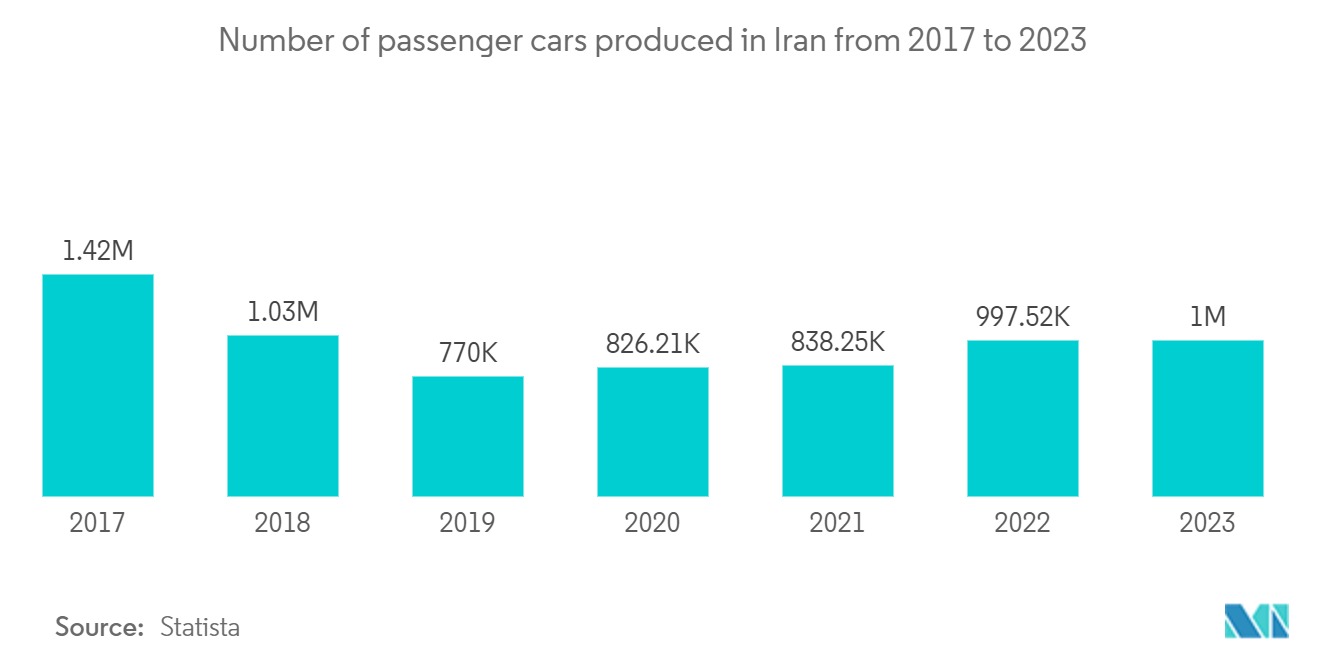
Government Regulations May Boost EV Sales in the Iranian Automobile Market
The Iranian government has shown increasing interest in promoting the adoption of electric vehicles (EVs) to reduce air pollution and dependence on fossil fuels and boost the domestic automobile industry. While the overall EV market in the country remains nascent, government regulations are expected to play a vital role in accelerating its growth.
The Iranian government has recognized the importance of reducing the environmental impact of transportation and has introduced a series of policies and incentives to encourage the adoption of electric vehicles. These initiatives include tax credits, subsidies, and reduced import tariffs on electric vehicles and their components. Such measures make EVs more affordable for consumers and create a conducive environment for manufacturers to invest in EV production. For instance:
- In October 2023, the Deputy Minister of Industry, Mine, and Trade for General Industries announced Iran's intention to collaborate with knowledge-based companies and domestic auto manufacturers to develop and produce domestically designed electric vehicles by 2025.
In 2023, Iran claimed to have identified lithium reserves, which, if confirmed, could amount to 8.5 million metric tons, or the second-largest such reserves in the world. This development is expected to boost Iran's EV manufacturing industry and help cut the cost of locally manufactured electric vehicles in the coming years.
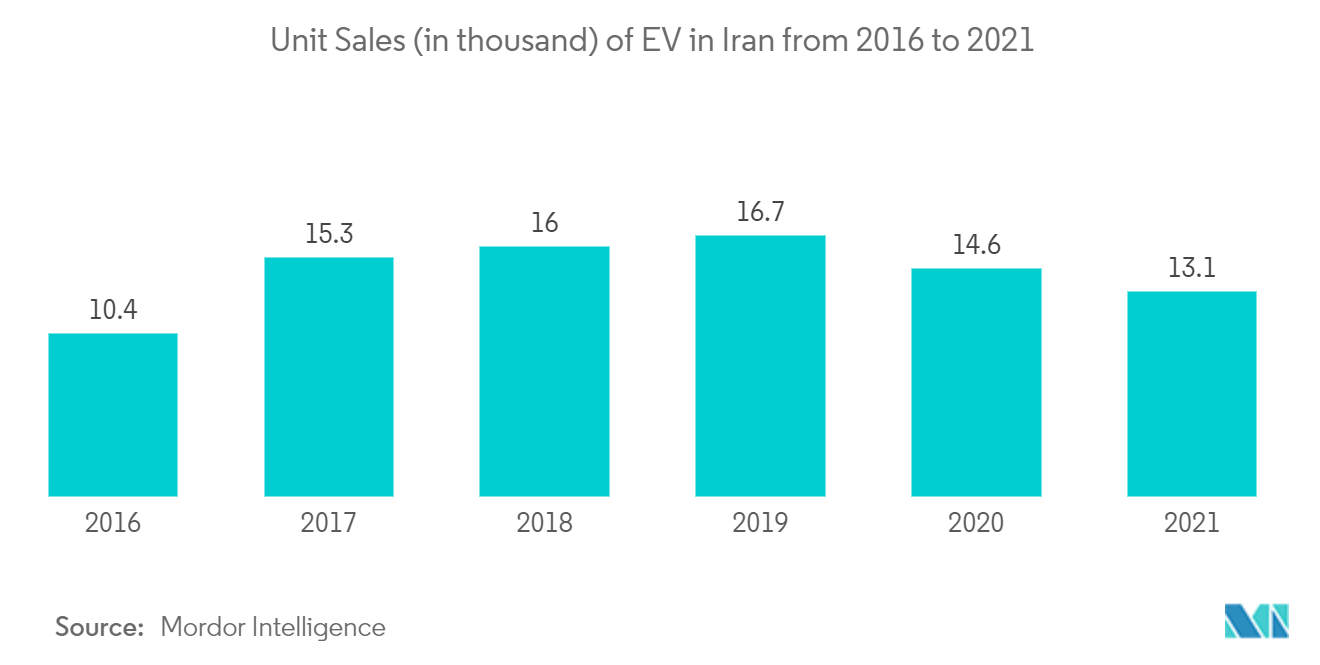
Iran Automobile Industry Overview
Iran's automobile industry is a moderately consolidated market. Many prominent local players in the country, such as IKCO, SAIPA, Pars Khodro, Kerman, and Bahman, manufacture various models (such as Samand, Tiba, and Dena). IKCO and SAIPA are the most prominent automotive manufacturers. Many players plan to ramp up production output in the coming years.
- In October 2022, the Iran Trade Promotion Organization (TPOI) announced the opening of an auto production line in Armenia to export manufactured cars to the Eurasian Economic Union (EAEU) states.
Iran Automobile Market Leaders
-
Stellantis N.V.
-
Iran Khodro
-
SAIPA
-
Volkswagen AG
-
Bahman Group
- *Disclaimer: Major Players sorted in no particular order
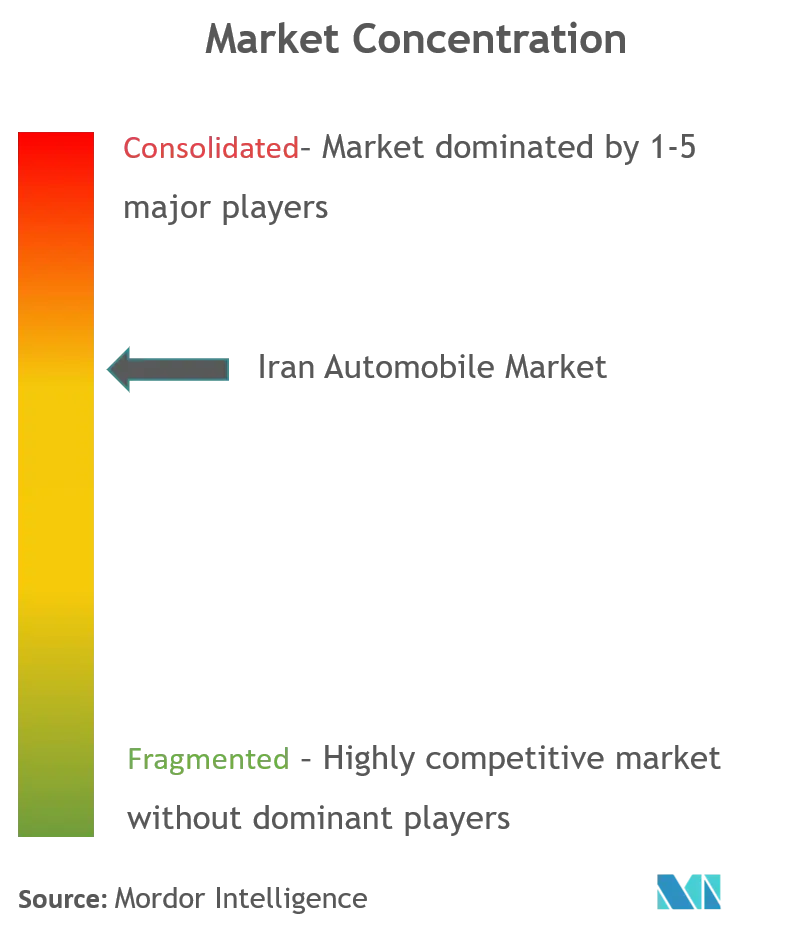
Iran Automobile Market News
- July 2023: Volkswagen's wholly-owned Czech subsidiary, Skoda, was poised to make a comeback in Iran's auto market after an absence of four decades. The reintroduction of five Skoda models to Iranian showrooms follows a revision of the country's car import regulations, which now permit the importation of new and used cars.
- October 2022: Iran Khodro Company (IKCO), the country's largest carmaker, unveiled its second new model in five months to diversify its products and increase domestic and international sales. The TF21 was unveiled during a ceremony at the company's headquarters in western Tehran. A 16-valve 110-horsepower TU5P engine powers the TF21, and it will be available with 5-speed manual and 6-speed automatic transmissions.
Iran Automobile Industry Segmentation
The automobile industry comprises a wide range of companies and organizations involved in designing, developing, manufacturing, marketing, and selling motor vehicles.
The Iranian automobile industry is segmented by vehicle type and manufacturer type.
By vehicle type, the market is segmented into passenger cars, commercial vehicles, and motorcycles. By manufacturer type, the market is segmented into auto ancillaries, engines, and other manufacturer types. The market sizing and forecasts are provided in value (USD) for each segment.
| By Vehicle Type | Passenger Cars |
| Commercial Vehicles | |
| Motorcycles | |
| By Manufacturer Type | Auto Ancillaries |
| Engine | |
| Other Manufacturing Types |
Iran Automobile Market Research FAQs
How big is the Iran Automobile Industry?
The Iran Automobile Industry size is expected to reach USD 41.59 billion in 2025 and grow at a CAGR of 9.57% to reach USD 65.69 billion by 2030.
What is the current Iran Automobile Industry size?
In 2025, the Iran Automobile Industry size is expected to reach USD 41.59 billion.
Who are the key players in Iran Automobile Industry?
Stellantis N.V., Iran Khodro, SAIPA, Volkswagen AG and Bahman Group are the major companies operating in the Iran Automobile Industry.
What years does this Iran Automobile Industry cover, and what was the market size in 2024?
In 2024, the Iran Automobile Industry size was estimated at USD 37.61 billion. The report covers the Iran Automobile Industry historical market size for years: 2019, 2020, 2021, 2022, 2023 and 2024. The report also forecasts the Iran Automobile Industry size for years: 2025, 2026, 2027, 2028, 2029 and 2030.
Our Best Selling Reports
Iran Automobile Industry Report
The Iran automobile industry, a key contributor to the nation's GDP, showcases resilience amidst challenges like economic sanctions and supply chain disruptions. With government support, including subsidies and infrastructure improvements, the sector sees robust growth in passenger cars, commercial vehicles, and notably, electric vehicles (EVs), driven by initiatives for clean energy. The industry benefits from a competitive landscape of joint ventures and startups, especially in the EV segment, indicating a shift towards sustainable transportation. Market analysis by Mordor Intelligence™ highlights the industry's expansion, with forecasts and historical overviews available in a free report PDF download. This blend of traditional and green vehicles positions the Iran automobile industry for continued development, leveraging government policies and market dynamics to navigate global challenges.




